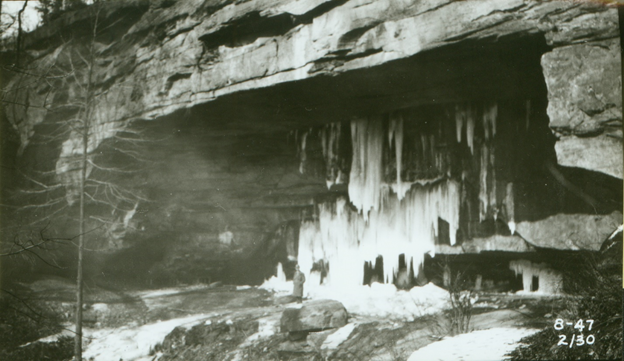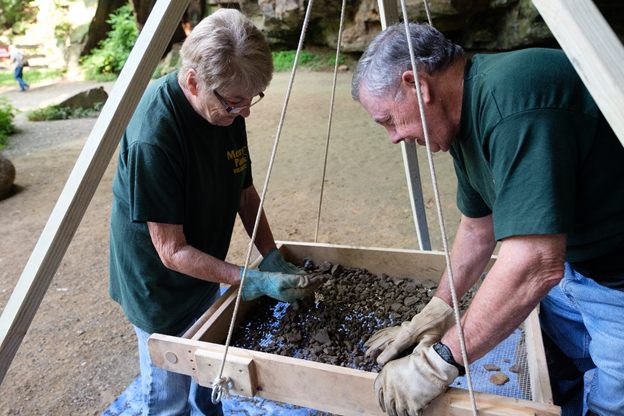Charlotte Gintert, Cultural Resource Specialist

The Summit Metro Parks Cultural Resource Management (CRM) division, with the help of SMP Citizen Science volunteers, completed an archaeological excavation of Old Maid’s Kitchen (formerly known as Mary Campbell Cave) in Gorge Metro Park during July and August of this year. The excavation took place in the footprint of a proposed environmental restoration project and with a purpose of identifying any archaeological materials present relating to prehistoric and historic use of the rock shelter, as well as to document the natural soil profile of the cave floor.
Historic research informed the team that fill soil (clay mixed with pea gravel) was laid in the floor of the rock shelter in 1931 to make the interior more accessible. Prior to the laying of the fill, historic photographs of the rock shelter show that the natural floor was sloped and wet.
After the CRM team took core samples to determine the depth of the fill, the SMP Operations Department removed this layer with a track hoe prior to the start of the excavation. This was done so that the excavation crew would not have to work through the tough clay by hand and to ensure the excavation was taking place in the native soils only.

At the conclusion of the project, excavation units had been dug to depths from 10 to 30 centimeters (4 to 12 inches). A continuous layer of shale rock was located at the base of every unit, which determined the natural stopping point of the excavation.

This shale layer is a natural layer and can be seen in the ledges at this depth throughout the Gorge area. No cultural activity could have taken place below this layer. The soils above the shale had not been disturbed and no archaeological features such as fire pits were uncovered. No artifacts were found below 20 centimeters (8 inches). The examination of the native soils during the excavation show that the rock shelter is naturally very wet and sloped. This would have made Old Maid’s Kitchen very undesirable for occupation or long-term use.

The excavation recovered 107 artifacts. All the artifacts dated from the historic period and all items that could be dated more specifically were manufactured from the late 1800s to the early 1900s. Ninety-nine percent of those items all preceded the placement of the fill soil in 1931. Artifacts of note include fragments of a Coca-Cola bottle manufactured in Akron, a Winchester Repeating Arms Co. .32 bullet casing and an Akron Pure Milk Co. bottle fragment.

No artifacts that could be associated with Native American use of the rock shelter were found, nor were artifacts found from the period of Mary Campbell’s time in Summit County. There was no indication that the rock shelter had been a habitation site for Native Americans during the prehistoric or historic periods.

The excavation did, however, confirm the importance of the Old Maid’s Kitchen rock shelter as a recreational site beginning in the late 19th century to the present day. Because of its importance to understanding the history of recreation in Ohio and Summit County, the site is being recommended as eligible to the National Register of Historic Places.
Interested in learning more? Check out the digital models provided by Dr. Jarred Lancaster of the University of Akron’s Department of Anthropology to explore the rock shelter and the excavation more closely!